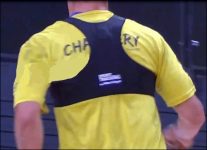
French handball team uses wearable RFID sensors for daily training
[ad_1]
Handball is a fast-paced indoor sport with 7 players per team, using the hand to dribble, pass, and score the ball into the opponent’s goal (handball is similar to football, but smaller). The Chambéry-Savoy handball team, located in the French city of Chambéry, is currently using an ultra-wideband RFID real-time location system (RTLS) to analyze player performance during training to provide better training. The team hopes to improve the league ranking through this training system. The solution, called BeSpoon Sport Edition, uses BeSpoon RFID tags, readers, and Mac-lloyd’s Sport-Tracking Fusion software, which records player movement, heart rate and transmits that data to team management.
The Chambéry Savoie men’s handball team is a registered team of the International Handball Federation. Before using this solution, teams used heart rate monitors to detect players’ heart rates. Laurent Munier, general manager of the team, said that the strength and conditioning coach can use this data to determine the training status and fatigue of the players. But the team didn’t find a way to track player movement, Munier said: “Accurately tracking player movement in motion is nearly impossible.”

Before using this technology, management and coaches could only judge players’ performance and provide training suggestions through visual observation. Camera-based tracking systems require a clear line of sight for individual tracking, which is sometimes not possible. Usually some manual intervention can ensure normal tracking.
For the past five years, French tech company BeSpoon has been developing a UWB-based system for player movement tracking. BeSpoon CEO Jean-Marie André said: “We realized that a wearable device could be a good idea. Wearable devices with built-in sensors could capture and upload personal health data. This could provide some data to the coach.” Although there are still some on the market There are other UWB solutions (such as the MotionWorks solution used by the NFL), but these are often expensive and difficult for small teams to afford.
According to André, BeSpoon and the French research center CEA-LETI have developed a small, affordable, wearable sensor. At the same time, the two sides also established a joint laboratory to develop commercially available UWB technology.
The BeSpoon Sport Edition scheme uses a battery-powered UWB tag that can transmit a 4GHz shortwave radio pulse multiple times a second. The handball team used a button-sized tag measuring 20 cm3, integrated into the back of a special tank-top garment inside the athlete’s clothing. The tag has a built-in UWB chip designed by BeSpoon and a heart rate sensor provided by Sport Tracking. The chip can transmit data to the reader within a range of 300 meters.
BeSpoon readers are similar in size to WiFi routers and can be mounted on walls around gyms. The reader can be connected to a computer via a wireless or wired network. Currently, the Chambéry Savoie handball team is using the system in its 4,500-capacity stadium.

The Chambéry-Savoy handball team has installed more than a dozen readers in the stadium. Teams can bind athlete’s name and their health data to the unique ID number of the tag worn by the athlete. After the sensor captures the athlete’s health data, the UWB chip transmits the data to the reader along with the tag ID number. The Sport-Tracking Fusion software runs on the BeSpoon server and analyzes the data and determines the location of the tags. The software can provide the team management with data such as player movement speed, bounce data, standing situation and so on. At the same time, the software also provides a view of the map situation, through which management can check the real-time movement of the athletes.
Munier explained: “We’ve always been interested in solutions for NFL clubs, but the budget just couldn’t support us. Before BeSpoon, we didn’t think the technology would come down in price for many years. The price of BeSpoon chips is really A catalyst. At the moment, players and coaches are reacting very positively to the technology.”
Munier added: “These numbers give us a better idea of the strengths and weaknesses of the players. This allows us to better help the players improve.”
Management hopes that as teams become more familiar with the technology, teams can gain more valuable data from the technology. “Our hope is that this technology can give us a view of a strategy game, focusing on one team, not just one player,” Munier said.
In the future, BeSpoon will also add functions to the software to provide media with player data during competitions.
(The exclusive manuscript of rfid world network, please indicate the source author for reprinting!)
[ad_2]



